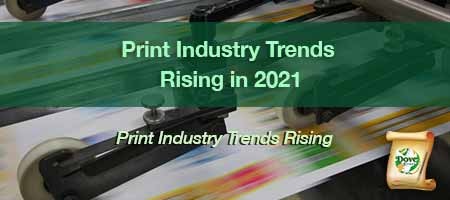Print Industry Trends Rising in 2021
Welcome to the Dove Direct Print and Marketing Blog. Today's post, "Print Industry Trends Rising in 2021," reassesses the latest print industry trends that are continuing to rise based on demands in 2020. Although we live and work in a digital world, the printing industry has evolved with technological updates, even though some marketers view print as an afterthought tactic. However, not all marketers maintain that view of print. Moreover, it should not surprise anyone that in 2021, printing technological advancements continue to gain a prominent foothold as they assist digital marketing efforts. It is also important to understand that the AMA (Amercian Marketers Association) has produced a bevy of reports based on data analysis that indicate direct mail marketing is not only an effective marketing tool, but also can increase engagement and response rates when used to direct mail recipients to digital destinations.
Our Quote of the Day:
"The Internet is so big, so powerful and pointless that for some people it is a complete substitute for life."
— Andrew Brown
We've presented notable trend reports with this blog, from digital to social media to print to human behavior traits and more. However, we find ourselves in yet another year when the technological advancements manifest in ways that can make a huge difference for both the consumer and industry.
The Internet of Things (IoT)
The Internet of Things (IoT) continues to change the game as more inanimate objects can communicate across a range of communication and inflection points, such as retail, food and beverage, automotive, healthcare, and the list goes on. Further, the commercial print industry is also dramatically benefiting as a direct result of IoT. Like other intelligent technologies, printing technology is also becoming more intelligent. The advances have enabled commercial printing service providers to save resources and paper, among other notable benefits.
IoT is responsible for bringing AI (artificial intelligence) to the game. It is the combination of AI and IoT that creates game-changing opportunities for everyone. This double technology punch makes it possible for better personalization, increased breach warnings, and the ability to predict paper usage. These advances have changed the game and enable print to be competitive in a digital world.
Speaking of changing the game, the AI and IoT are reminiscent of league-leading basketball players. Bill Russell was the first acclaimed center to defend, pass, shoot, and rebound above his counterparts while playing the center position throughout the league. Further, the 2020-21 basketball season witnessed a 33-year-old, Steph Curry, lead the NBA in scoring without the help of a shooting sidekick, which made it much more difficult for him to score when multiple players from the opposing team could double and triple team his scoring efforts. Curry changed the game because no one in basketball can shoot 3 point shot attempts while on the move the way he can, or consistently from great distances at such a high percentage. Likewise, print technology changed the game for direct mail marketing. Marketers can feed data points to a digital printing press that will, in turn, print personal individual print pieces for each targeted recipient, combined with data points such as household income, ethnicity, education, purchasing habits, travel, homeowners, renters, etc..
Print's Security is More In Demand
In the early days of the internet, and more recently, cybersecurity is of rising concern because cyber crimes are accelerating and growing in stature. The impact of breaches has demonstrated that these attacks can impact anyone and everyone, including government agencies, small and large businesses, entrepreneurs, and encompasses both the public and private sectors.
Nor is the printing industry exempt from cyber malfeasance. Cybersecurity is now a must-have for print providers who have always provided security for print services, products, and customer data. The continuing need for securing sensitive data for customers is of paramount importance, and therefore marketers must take care to implement cyber-secure programs to guard against tampering or hacking. This security trend is continuing throughout 2021 and will likely be the new norm from now on.
Document security must take center stage as the primary focus for the print industry, as it relates to handling sensitive documents, now and in the future. Full-service commercial printers will benefit by ensuring a heightened robust data security infrastructure. Commercial printers that promote a secure data component as part of their offerings and solutions can provide customers with a higher level of security for critical/confidential documents such as HIPPA, financial, insurance, ID cards, exam reports, and other sensitive information.
The Art of Shimmering
Shimmering, the art of instituting a multi-part process that creates unique effects on virtually any stock, is rising. This shimmering technique can highlight one or more print design areas, providing an element that stands out from the rest of the document. In some cases, it can produce a 3-D like effect. The applications are already well-sought after, particularly for finished print products, including business cards, high-tech direct mail pieces, covers for business presentations, restaurant menus, wedding invitations, annual reports, and many other applications. You can expect to see more of this trend during the holiday season and as we head into 2022.
Print Sustainability
As the discussion heats up regarding climate change, the idea of a sustainable planet generates a need for businesses to adopt an Eco-friendly mission. No industry or organization will be exempt from the pressure by consumer groups that demand enterprises incorporate Eco-friendly printing methods. One could assert that the 800-pound gorilla in the printing industry is the acknowledgment that the environment is becoming more unlivable every day.
No longer will print sustainability methodologies be an option. Millennials and the generations that follow are keenly aware of the challenges a sustainable earth presents. We can all thank Greta Thunberg for her persistence.
The good news, low-carbon printing capabilities are already underway. To that end, HP has taken the challenge of initiating low-carbon printing. The goal of HP's project is to reduce its environmental impact. We will have to wait and see if other companies will follow HP's lead.
Eco-friendly conscious consumers will play a considerable role in mandating boycotts of companies that fail to initiate sustainable policies. As Australia, Greece, California, and other cities and countries burn or flood, the planet's near-term crises will only increase consumer awareness and thus will impact companies that fail to adopt earth-friendly policies. Climate change has seen this trend gain more attention in 2021, particularly as the world continues to experience record-setting fires across the globe, decimating homes, wildlife, and forests.
The E-commerce Affect
Throughout the second half of 2020 and well into 2021, consumer behavior proved to be solidly entrenched depending on e-commerce for all manner of products, including groceries, automobiles, and all forms of retail goods. E-commerce had already been rising for several years, mainly as broadband providers deliver more speed and reliability. However, the pandemic made e-commerce a global trend overnight, giving it the runway to take flight in the e-commerce stratus sphere.
Full service, commercial print companies that invest in and set up or partner with an e-store can offer consumers the opportunity to purchase print products online. Books, explanatory documents, journals, booklets, promotional materials, annual reports, and the like can be extended in combination by brands. That combined offer extends online, in print, and brick and mortar, thereby unlocking a new base of customers. This effort can result in having access to a larger consumer target pool, which is tantamount to higher opportunities for sales growth. Any print provider who takes the e-commerce plunge will rise above competitors that fail to do so. Look for this trend to continue and grow in 2021.
Direct Mail Campaigns on the Upswing
Print's direct mail marketing campaigns are considered essential advertising mediums, along with blogs and email marketing. One could also argue that social media marketing is a basic form of marketing; however, with the advent of overcrowding internet usage brought about by lockdowns, many users do not see enough digital ads. Direct mail marketing, a product of variable digital printing (VDP), can offer custom design elements created via an individually sourced list. As in the old days, brands can include marketing materials in a mailer packet that features multiple organizations. Direct mail marketing is considered the leader when looking to engage new customers.
There are also obvious benefits for existing and inactive customers. When you compare engagement and conversion rates, direct mail marketing campaigns are efficient ad spends that provide a stellar method to improve brand awareness and recall for organizations to maintain their image, solutions, and services front and center in the public arena. Direct mail as a percentage of the marketing spend will continue on an upward trend throughout 2021.
Print on Demand
Print-on-Demand has a trend of its own, and to that end, print-on-demand is rising more and more as each year passes. More importantly, more and more e-commerce store owners partner with print suppliers while investing in e-commerce. What does this mean? The ability to print custom orders from your e-store will result in more profits from a new revenue stream. In addition, by offering print-on-demand services for e-stores, printers can increase the overall revenue stream.
If you notice, the iconic players in e-commerce are now extending print-on-demand services as part of their e-stores offerings. Commercial printers should be frothing at the mouth to nail down a successful e-store that offers an installed base of customers. 2021 will see more consideration of this type of partnership with commercial printers and e-commerce organizations.
Digitized Processes
Digitization has been on the scene for several years and is increasing in every industry. That said, the print industry as a whole lag embracing digitization as a competitive offering. Digitization provides methods to streamline how customers access a print vendor and perform certain functions, such as scanning and storing documents using their smart devices.
Further, customers can send their documents to print suppliers for print jobs whenever they need to initiate a job request. This process serves as a more efficient method that reduces waste while simultaneously printing only what's necessary. More importantly, this digital method reduces the requirement for inventory management. For example, digital mail scanning has come of age due to work-from-home initiatives set forth by several iconic brands. Employees working from home also need to access organizational mail. A relatively new service, digital mail scanning, allows the WFH personnel to access any correspondence in a timely fashion without the organization needing to resend or secure mail at multiple locations. Expect digital scanning services to continue to rise in 2021.
The Net-Net
These print industry trends are not new. However, commercial printers willing to enlarge their comfort zone will find that the print trends discussed here can make a considerable competitive difference in 2021 and beyond. Digitalization, AI, IoT, Print on Demand, eCommerce Integration, Print Security, and Print Sustainability are all methods commercial printing vendors can utilize to increase brand equity and garner more revenue. We hope you enjoyed this article and thanks for reading "Print Industry Trends Rising in 2021"!
Let's talk about integrated business solutions and how they can move your messages forward, help grow your business, change behavior, and improve the customer experience. Let us show you how to improve your document processes to optimize your workflow, reduce costs, and maximize your organization's printing, letter shop, and mailing capabilities.
Dove Direct has an official USPS certified bureau located within our offices to save you time and money. We can even create a demo file for you. For more information, call Carla Eubanks at 404-629-0122 or email Carla at This email address is being protected from spambots. You need JavaScript enabled to view it..
Dove Direct, your Atlanta based print and mail solutions provider, offers organizations end-to-end data, printing, and mailing solutions:
- Data Management
- Variable Digital/Data Printing
- LetterShop and Fulfillment
- Digital Mail Scanning Services
- Fully Automated MLOCR Presort Bureau
- Marketing and Production Management Support
- Secure Data Life Cycle Management
If you don't want to wait, you can reach Dove Direct today by calling 404-629-0122 or complete the Contact Form.





